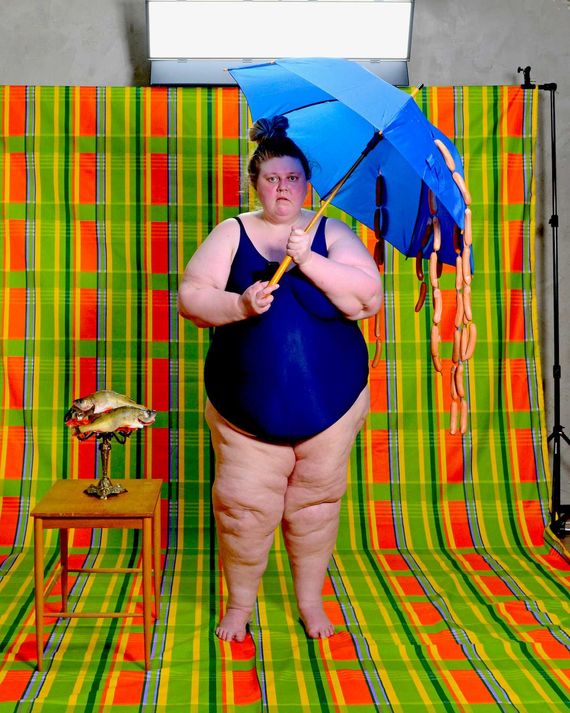
Iiu Susiraja comes from a long tradition of photographers who stay at home, dress up, and take pictures of themselves. Claude Cahun, Catherine Opie, Patty Chang, Cindy Sherman — they are there and not there in their images, playing cat and mouse with that elusive animal called identity, enacting dreams and surfacing subconscious anxieties. Susiraja is different: nearly six feet tall, heavy, inescapable. No matter what costume she puts on, no matter what pose she strikes, something bursts through that’s undeniably her. “Being fat is a transgression in itself,” she has said. “I try to be empty and boring, but the camera is more cunning than me.”
She is always alone in her photos at home or in her parents’ house in Turku, Finland. She often uses patterned backdrops — bright plaids, flowery wallpaper, trippy fabrics — that have the feel of nicely designed prisons, their artifice exposed by rigging and a large LED panel that softly backlights her. She deploys normal household items, like sausages and ironing boards and Christmas trees, as props, though in her hands they become absurd, the accoutrements of a tragicomic antisocial heroine masquerading as a housewife. In her current show at MoMA PS1, “A style called a dead fish,” we see her with her leg caught in a top hat, a toilet plunger over her mouth, an ice-cream cone on her face. She subverts our notions about domesticity and sexuality, health and beauty, becoming an object of her own debasement and glorification, a vision you cannot look away from.
In Siivouspalvelu (Housekeeping service), she is framed by a doorway with a rainbow feather in her ass. Sausage Cupid features Susiraja in a one-piece bathing suit, holding a blue umbrella with garlands of raw sausage attached next to furniture that looks like a desk lamp but on closer inspection is a bunch of dead fish, the whole assemblage a cross between clean, minimal Scandinavian design and the dark fantasies of the id. Broom finds her in a dining nook wearing a broom beneath her breasts, one of the many lurid jokes in her work that feel like challenges or indictments. In Airplane, she stands on a StairMaster holding plastic bags, both an ad for fitness and an insurrectionary statement against all ads for fitness.
“I don’t try to take any role,” Susiraja has said. “I want to be as real as possible. As blank as possible. For me, being blank is the same as being real.” Her work echoes that of British artists Sarah Lucas and Richard Billingham. Lucas turns the camera on herself and stares us down, daring us to respond. Billingham exposes his drunken family at home in government housing, the realness here being that of class. Susiraja gives us very little idea of her class, other than that she belongs to the broad, social-democratic middle. There is no one else in this world but her, this visual predicament. “I feel I was a controversial person as a child and also now as an adult,” she told Autre magazine.
The light in these photographs, to which our attention is so overtly drawn, is a co-star. Clear and vivid, it gives a spacious monumentalism to the work. The objects are used in ways that tumble in the mind, never really settling, which keeps the work alive — stops it from being a gimmick. No action is taking place, such that the compositions resemble Dutch still lifes. “My starting point is purely the object and how it relates to me,” she says. “The object is a tool for experiencing partnerships.” And what strange partnerships these are: a clothespin affixed to her nose, a baguette caught in her crotch, as if to say a person like her just doesn’t make sense in this world. This awful isolation is pronounced in the pictures of her in bed: her naked rear, a horsey doll stuck in her underpants.
The main event, though, is that body, which is so relentlessly exposed, complicating the messages of body positivity that have dominated the recent discourse around obesity. Susiraja seems intent on revealing every fold, every craggy dimple, as if her body were a map in raised relief of her happiness and her pain. At times, the echoes of art history are difficult to escape: small feet, big belly, big chest, a combination of attributes that was once considered ideal, a Venus figurine. Yet she is also just herself, “empty but alive,” as she says. Her face is inscrutable. She has passed through all these metamorphoses only to remain what she is: a plain fact.
“Iiu Susiraja: A style called a dead fish” is at MoMA PS1, through September 4.

